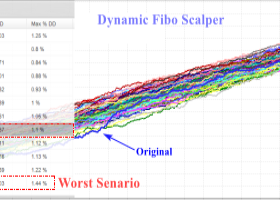
New CNY High Est 6.75-7.0; On/OffShore Spread Narrow - Analysts
The turmoil generated by the June 23 UK Brexit vote has prompted analysts to adjust their yuan calls going forward to reflect renewed weakness against the dollar, with the new 2016 forecast for the high range from CNY6.7500 to CNY7.000.
USDCNY closed at CNY6.6860 Tuesday, after trading in a CNY6.6611 to CNY6.6938 range. The earlier high of CNY6.6938, was the highest level since Nov. 02, 2010, when the pair topped out at CNY6.6964. On Sept 2, 2010, USDCNY posted a high of CNY6.8175, which will be the next larger topside target.
Copy signals, Trade and Earn $ on Forex4you - https://www.share4you.com/en/?affid=0fd9105
The USDCNY low of CNY6.4528, seen March 31, was the lowest (highest yuan level) since Dec. 11, 2015, when the pair bottomed at CNY6.4390. The March 31 close of CNY6.4536 was the lowest since Dec. 10, when the pair closed at CNY6.4386.
Since the UK Brexit vote, the yuan has traded in lockstep with other emerging market currencies versus the dollar, moving first lower, then higher and now lower again.
In the wake of the UK vote to leave the European Union, Credit Agricole CIB has revised their dollar-yuan calls for the onshore and offshore yuan, said Dariusz Kowalczyk, senior emerging market strategist at Credit Agricole CIB.
"We now predict modest depreciation of the RMB in 2016 on an annual basis rather than moderate appreciation, to 6.60 for both exchange rates, on a likely prolongation of the period of capital outflows. An annual peak should occur in mid-Q3 at 6.75 for USD/CNY and 6.80 for USD/CNH," he said.
CA CIB maintained their view for the yuan to begin to appreciate more in 2017, driven by "portfolio inflows related to SDR inclusion and the onshore bond market opening, as well as future inclusion of onshore equities into global indexes."
At the same time, "we reduce the magnitude of expected gains, targeting 6.50 by year-end, on a faster than anticipated swing of direct investment balance to a deficit," Kowalczyk said.
The yuan should see "further, limited gains in 2018," but thereafter there is scope for a turnabout lower "on the disappearance of the current account surplus in 2019 and rising risks related to the stability of the banking sector," he said.
BOA Merrill Lynch strategists Adarsh Sinha and Claudio Piron revised their CNY forecasts also and looked for dollar-yuan to end 2016 around CNY7.0000 versus CNY6.9000 previously.
"For USD/CNH the profile is 7.00 and 7.10 for end-3Q and end-4Q respectively," they said.
"This recognizes the negative hit to GDP growth and the greater likelihood of China's policy makers allowing for further CNY weakness to fend against the softer growth outlook," Sinha and Piron said.
BOA Merrill has revised its Q3 USDCNY forecast to CNY6.8000 from CNY6.7000.
Regarding recent trading action in the yuan, while USDCNY has been on the rise, "speculative pressure points, such as the forward premia and onshore-offshore basis were well contained," the strategists said.
In addition to yuan weakness, market players have also been watching the spread between the on-shore and off-shore yuan to see if the spread might again begin to widen in a more meaningful way, as seen in early 2016, which would suggest rising risk aversion.
The spread did widen initially as part of the initial fallout from Brexit, but has since narrowed back to pre-Referendum levels.
Some analysts wondered if a lack of interest in the off-shore yuan is behind the recent spread narrowing and not necessarily relative calm.
The PBOC intervened heavily on Jan. 12, 2016 in order to narrow the spread between the on-shore and off-shore yuan, which had widened to over +1,400 pips in the first week in January as speculators entered into CNH shorts on expectations of a higher USDCNY.
This forced the PBOC to intervene, as one of the conditions of the yuan's entry into the IMF's SDR basket was to close the gap.
In subsequent months, the CNH-CNY spread has narrowed markedly, reflecting overall improved risk appetite. The spread widened in response to the June 23rd Brexit vote, but has since narrowed again.
Tuesday's CNH-CNY closing spread (at 11:30 local time) was +79 pips versus +103 pips Monday and +123 pips last Friday. The June 27 closing spread of +396 pips was the widest since Feb. 3 when the spread also +396 pips. The spread was +437 pips on Feb. 2. At the most recent peak of risk appetite, seen March 18, the closing spread was -100 pips.
The PBOC set the yuan fixing at CNY6.6594 versus the dollar Tuesday, compared to a central parity of CNY6.6472 Monday. Tuesday's fixing was the highest fixing level for USDCNY (weakest CNY level) since the end of 2010.
On global investor interest in the off-shore yuan, "total offshore yuan deposits in Asia are continuing to shrink in dollar-terms following last August's yuan devaluation," noted Mansoor Mohi-uddin, senior market strategist at RBS.
At the same time that yuan deposits in Hong Kong, South Korea, Taiwan, and Singapore have declined from $271 billion in the summer of 2015 to $185 billion as per May 31, Chinese corporate's on-shore dollar-denominated loans have fallen from $937 billion to $780 billion, he noted.
"Domestic firms appear to be paying down FX loans by cutting both on-shore and off-shore yuan deposits," Mohi-uddin said.
With the PBOC willing to raise its daily on-shore dollar-yuan fixing to reflect dollar strength versus sterling and the euro in the wake of the UK referendum results, China corporates have an incentive "to keep paying down FX denominated loans," he said
That offshore yuan deposits are falling and on-shore dollar loans are contracting "suggest the yuan will each 6.80 in the next few months," he said.


